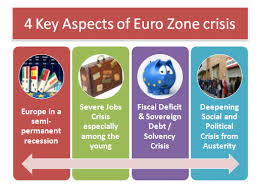The Eurozone is an economic and monetary union, which consists of 19 countries within the European Union, which in itself is a confederation of 28 nations primarily from Europe, forming an economic union. The countries of the Euro zone (euro area) use a common currency called the Euro and share a common independent monetary policy which is presided over by the European Central Bank.
The Euro zone sovereign debt crisis reflects the still mounting and enormous debt of some of the individual governments of the Euro zone, and their inability to refinance these debts. The countries which could not put their public debt in order and received huge bailout packages from the Euro zone countries and the IMF include Greece ,Ireland and Portugal- in that chronology. The causes of the crisis range from –
- Interest rates, which had fallen to unprecedented lows in southern European countries when they joined the euro. And that encouraged a debt-fuelled boom, causing governments as well as the private sector (causing companies and mortgage borrowers) to borrow beyond their means, and the subsequent bail-out packages to the troubled banking industries and financial sector by the governments which raised their debt levels even more. Also reckless public sector spending especially by Greece on social security measures like increasing minimum wages drove up labour costs without raising productivity.
- Real estate bubble bursts followed by writing off of assets post the global meltdown.
- International trade imbalances of the debt ridden Euro zone nations.
- Downgrade of the nations’ debt by credit rating agencies leading to spiraling bond yields which further intensified the crisis.
In 2011, euro zone finance ministers set up a permanent bailout fund, called the European Stability Mechanism, worth about 500bn Euros to help the crisis countries.The Southern Euro zone nations of Greece, Portugal, Spain, etc were trade deficit nations due to their noncompetitive exports (high labour costs) and high imports (financed by the borrowing boom). They had their deficits with the northern European nations (especially Germany), raising their debt levels and fuelling the crisis
Click here for government certification in Accounting, Banking & Finance





6 Comments. Leave new
Good effort!
Well explained.
Informative
EuroZone debt crisises have worldwide impact. It is high time that European union undertake adequate measures to mitigate this risk.
very interesting.
Got something new to read:D
The content is well put and the comparision of economy of different nation was really good 😀
And at least intorducing the survey for analysis was also good 😀
Waiting for more from you 😀
Good work 😀